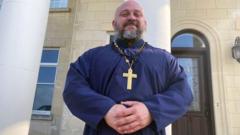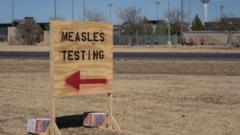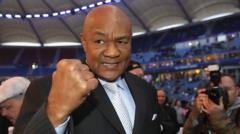In a surprising cultural shift, young men in the U.S. are turning to Russian Orthodoxy, prompted by its emphasis on traditional masculinity, family life, and a rejection of modern societal norms. This movement, led by charismatic figures like Father Moses McPherson, reflects broader trends in faith and identity.
American Men Embrace Russian Orthodoxy in Search of Traditional Masculinity

American Men Embrace Russian Orthodoxy in Search of Traditional Masculinity
A growing number of young American men are converting to the Russian Orthodox Church, drawn by teachings on masculinity and family values.
Young American men are increasingly finding solace in the teachings of the Russian Orthodox Church, specifically in its branches such as the Russian Orthodox Church Outside Russia (ROCOR). This shift is largely driven by an appeal to traditional masculinity, with many converts citing dissatisfaction with modern societal norms regarding gender roles.
Father Moses McPherson, a prominent priest in Georgetown, Texas, has become a symbol of this movement. In his online videos, he advocates for a virile masculinity, often mocking modern behaviors like wearing skinny jeans or engaging in domestic tasks deemed too feminine. Having transformed his church from a modest congregation into one that has tripled in size over the past 18 months, he draws in young men eager to assert their identities as supportive and traditional figures within their families.
One convert, Theodore, encapsulates this yearning as he expresses feelings of emptiness despite career success and personal happiness. Rather than adhering to what he views as a "toxic" societal narrative about masculinity, he, along with others, turns to Orthodoxy in search of a faith that aligns with their beliefs about family structures and gender roles.
Many of these young men and fathers are also choosing to home-school their children, influenced by the church's emphasis on traditional family values and a desire to avoid liberal ideologies. They reject contemporary teaching methods in favor of a religious upbringing, with figures like Father John Whiteford advocating this approach as protective and beneficial.
Statistics from the Pew Research Center show a notable increase in male Orthodox Church membership, suggesting that the trend of conversion is not just anecdotal. The pandemic served as a catalyst for many, prompting a reevaluation of life choices and faith, driving them towards the more conservative practices observed in Eastern Orthodoxy.
The digital media landscape has amplified this trend; Father Moses boasts a significant online following where he presents these ideals. Activities centered around masculinity, marriage, and parenthood resonate deeply, as many young men see the community as a refuge from the perceived feminization of modern religion.
However, these converts often hold conservative views that may clash with the progressiveness of today's society. Elissa Bjeletich Davis, a Sunday school teacher, notes that many new members embrace an authoritarian view on religion, while Buck Johnson, another convert, reflects on how this shift is not just a personal spiritual journey, but a strategic rejection of certain contemporary American values.
This movement has sparked broader discussions about identity, belief, and the perception of masculinity within faith communities. As young men actively seeking out these teachings grapple with societal expectations, they find themselves exploring the depths of their faith in an environment that respects traditional roles and familial structures, marking a significant cultural moment in American religious life.


















